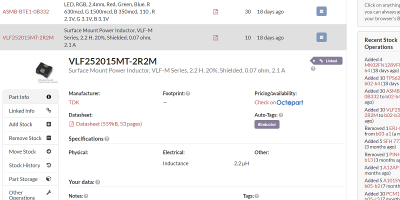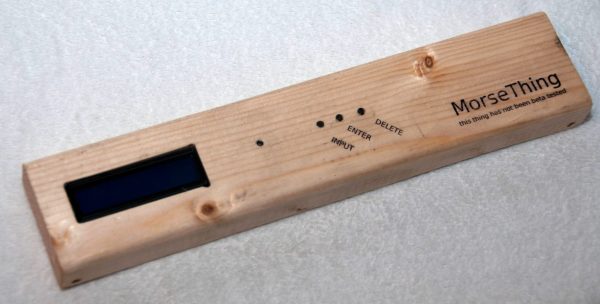Shortwave listening has always been a mainly nocturnal hobby. To get the real DX, one had to wait for favorable ionospheric conditions after sunset and spend hours twisting knobs while straining to pick voices from half a planet away out of the noise. But who has time for that in today’s world? And what of the poor city-dwelling SWL, with antenna limitations and often elevated noise floor in the urban jungle?
Continue reading “Cache Shortwave Signals For Later With This SDR Spectrum Grabber”
Day: November 18, 2016
Need An Enclosure? Try Scrap Wood With Toner Transfer Labels
This utilitarian-looking device takes an unusual approach to a problem that many projects face: enclosures. [Jan Mrázek] created a device he calls the Morse Thing for a special night’s event and used what appears to be a humble two-by-four plank for the enclosure. The device is a simple puzzle using Morse code and was intended to be mounted to a railing, so [Jan] milled out the necessary spaces and holes for the LCD and buttons then applied labels directly to the wood via toner transfer – a method commonly used for making PCBs but also useful to create clean, sharp labels.
Continue reading “Need An Enclosure? Try Scrap Wood With Toner Transfer Labels”
Only One Button? No Problem!
Sometimes less is more. This is especially true when dealing with microcontrollers with limited I/O pins. Even if you have lots of I/O, sometimes you are need to pack a lot into a little space. [Hugatry] was inspired by the simple interface found on a lot of flashlights: one button. Push it and it turns on. Push it again, and it switches modes. You cycle through the modes until you finally turn it back off. One button provides mutliple functions. The question is how can you use a power switch as an I/O device? After all, when you turn the power off, the microprocessor stops operating, right?
[Hugatry’s] answer is quite simple. He connects a resistor/capacitor network to an I/O pin (or multiple pins). When the processor turns on initially, the pin will read low and the capacitor will charge up. If you turn the power off, the CPU voltage will fall rapidly to zero, but the voltage on the capacitor will discharge slower. If you wait long enough and turn the power on, there’s no difference from that first power on event. But if you turn the power on quickly, the capacitor voltage will still be high enough to read as a logic one.
What that means is that the processor as part of its start up can detect that it was recently turned off and take some action. If it remembers the previous state in nonvolatile memory, you can have the code cycle through multiple states, just like a flashlight. You can see a video of the setup, below.
Building A LoRa PHY With SDR
The Internet of Things is terrible when it’s your toaster. The real fun happens when you have hundreds or thousands of sensors sending data back to a base station every day. That requires low power, and that means LPWAN, the Low Power Wide Area Network.
There are a lot of options for LPWAN, but few are a perfect fit. LoRa is one of the rare exceptions, offering years of operation on a single AA cell, and range measured in miles. Layers two and three of LoRa are available as public documentation, but until now layer one has been patented and proprietary. At the GNU Radio Conference, [Matt Knight] gave a talk on reverse engineering the LoRa PHY with a software defined radio. Now, LoRa is open to everyone, and anyone can decode the chirps transmitted from these tiny, low power devices.
Partsbox.io Wants To Organize Your Junk Box
There are many ways to divide the hacker community into groups. Tubes vs transistors. Emacs vs VI, microcontroller vs discrete component designers. However, one of the more fundamental divisions in the community is how you organize your parts. We’ve seen giant warehouses with carefully organized bins and cabinets full of components, and we’ve seen storage crates with tangles of wires and bits of electron-bending components scattered among the wires.
 If you are in the former camp, you’d probably enjoy partsbox.io (see image, right). If you are in the latter group, you probably need to check it out even more than the other people. The idea is simple: an online place to keep an inventory of your electronic parts. The implementation is not as simple, though. The web application will work on a mobile device or just about anywhere. You can view your components by type, by location (the shoe box under the bed vs the parts bin in the closet), or by a project’s bill of materials. You can use “known” parts or create private parts for things no one else has (for example, your custom PC boards, or those 3D printed brackets you made to hold a microswitch). If you add data for a component you can make it available to other users.
If you are in the former camp, you’d probably enjoy partsbox.io (see image, right). If you are in the latter group, you probably need to check it out even more than the other people. The idea is simple: an online place to keep an inventory of your electronic parts. The implementation is not as simple, though. The web application will work on a mobile device or just about anywhere. You can view your components by type, by location (the shoe box under the bed vs the parts bin in the closet), or by a project’s bill of materials. You can use “known” parts or create private parts for things no one else has (for example, your custom PC boards, or those 3D printed brackets you made to hold a microswitch). If you add data for a component you can make it available to other users.
Continue reading “Partsbox.io Wants To Organize Your Junk Box”
3D Printering: Smartphone Resin Printers Actually Work
Last spring, the world saw something amazing. It was a device that would revolutionize the planet, save the world, and turn your smartphone into a 3D printer. Kickstarters aren’t known for selling themselves short. I speak, of course, of the OLO 3D printer, later renamed the ONO 3D printer, ostensibly because of a trademark dispute.
While filament-based 3D printers are extremely capable and slicing software is only getting better, resin-based printers are able to produce prints of nearly unparalleled quality. If you want high-resolution objects and fine detail, a resin printer is the way to go. These resin printers, however, are a bit more expensive than your traditional filament printers. A few hundred dollars will buy you a serviceable i3 clone, and less than a thousand will get you a real Prusa capable of printing in four colors. The premier desktop resin printer, the Form 2 from Form Labs, starts at $3500 USD.
Continue reading “3D Printering: Smartphone Resin Printers Actually Work”
Vintage Computer Festival Switzerland This Weekend
This weekend marks the Vintage Computer Festival Europe – Switzerland, a two-day extravaganza of vintage hardware held in Zurich, Switzerland.
Of interest for this VCF will be an LGP-30 replica (a computer without RAM or ROM released in 1956), an IBM System/360 front panel, lots of blinkenlights, Swiss computers, and [Oscarv], creator of the very successful PiDP-8/I project on Hackaday.io, will be there with his minified PiDP-11/70. If you don’t have one of [Oscar]’s PiDP8 machines sitting on your desk yet, don’t worry — the 11/70 is the one you really want. It is beautiful.
As you would expect from a Vintage Computer Festival, all the standards will be there. The flea market is open, soldering stations are present, talks will be held, and very old and very rare hardware will be blinking. From our experience with Vintage Computer Festivals, Europe does it right. Last year’s festival in Munich was a blast, and this year’s celebration in Zurich looks like it will be as well.


















